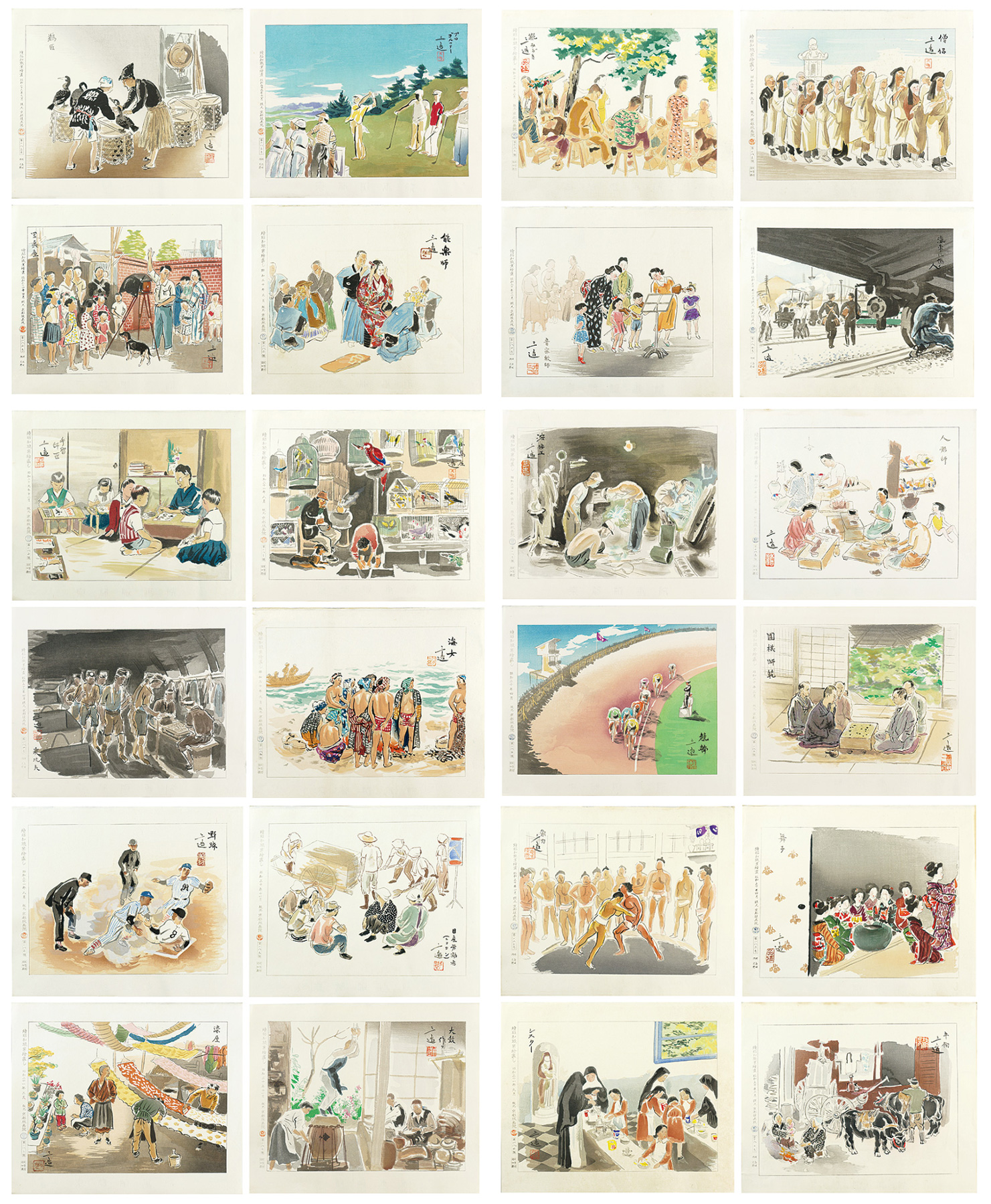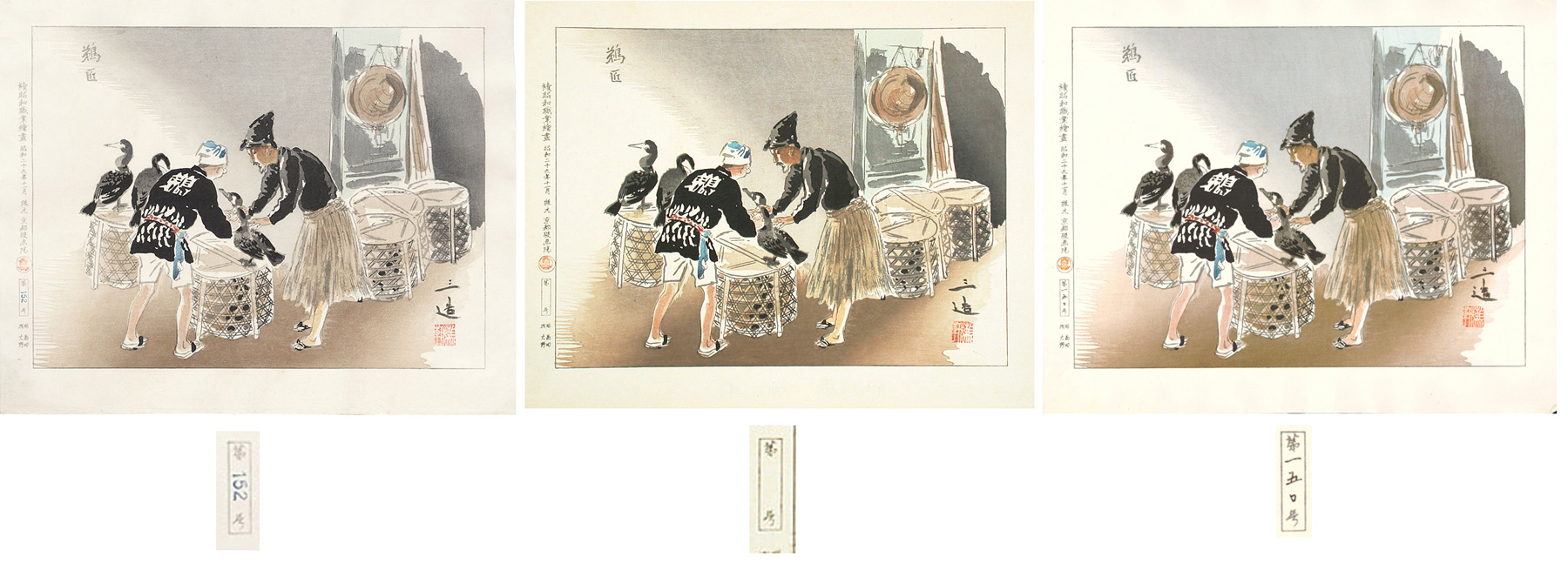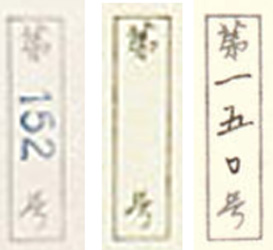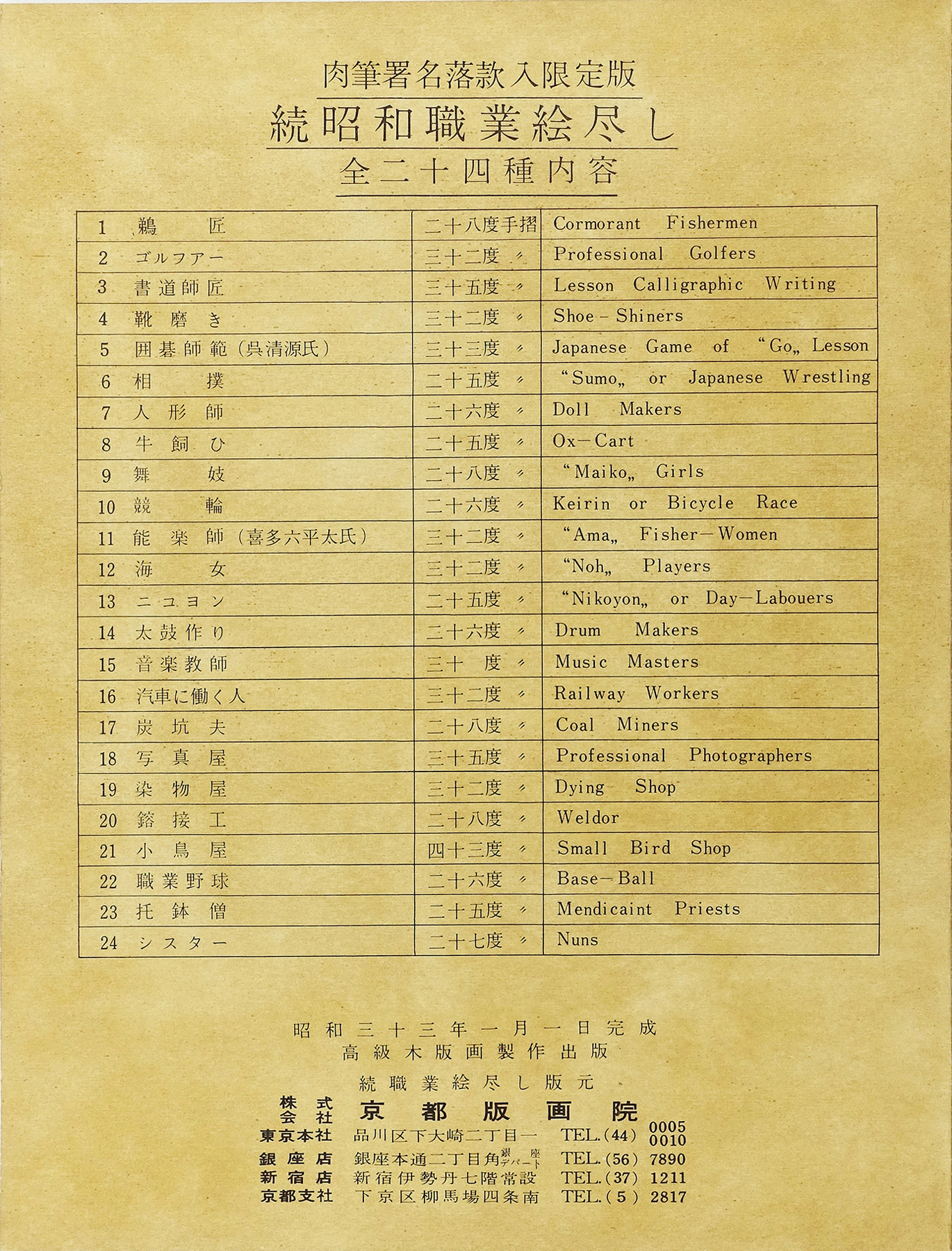About This Print
Day laborers, known as Nikoyon after the paltry wages they were paid after the war of 240 yen per day (less than a U.S. dollar a day) are either awaiting work in the foreground or at work with shovels and pushcart in the background.1 This print is one of twenty-four in the post-WWII print series Occupations of Shōwa Japan in Pictures, Continuing (3rd series), published from November 1954 through September 1956 by the publisher Kyoto Hangain.
Shinagawa Kyoomi, owner of
Each print in this 3rd series came with an attached sheet (printed on a tissue-type paper) of commentary, written in both Japanese and English (translations by Shiraishi Fumio). In regards to the English translations provided, Memories of Shōwa: Impressions of Working Life by Wada Sanzō (p. 65) notes, "A different translator [from the pre-war series] worked on these descriptions, and some content was specifically edited for the English versions." The authors provide translations, shown in brackets below, of any significant lapses in translation that appear in the English translations on the commentary sheet.
Commentary sheet attached to print
The below excerpt from the U.S. Army Area Handbook for Japan written in 1961 provides the following description of Nikoyon, sounding much like Wada's:
"Nikoyon" or Day-labourer The day-labourers are generally called "Nikoyou" in Japan. This slang expression was originated from the fact that they earn two hundred forty yen (or Nikoyon) for one day's labour.They go to the labour-offices each day early in the morning in hopes of getting a job. [There are quite a few people who return home without purpose, who only 'work and eat' because they are unable to obtain a proper livelihood.] Most of them are engaged in sweeping and cleaning parks or roads. Recently, their wages are said to have been elevated to a little more than two hundred forty yen; however, it is still very trying for them to live on such a low wage-scale established by the government during that chaotic time after the war. All the labouers who go to the labour offices, do not always get jobs. Most of these people who have no other particular ability have not other way to sustain themselves but to sell their labour. Consequently they work without spirit and this represents one of today's biggest social problems.It is noted in Memories of Shōwa: Impressions of Working Life by Wada Sanzō (p. 81) that "Wada's personal observations of day labourers are a little more specific in the Japanese text:"The appearance of them working on roadworks or cleaning parks is not of people who have chosen to devote themselves to this work, so there is no doubt they work hard driven by their serious mentality.They therefore cram every minute with work. They start early in the morning, taking a lunch break at three o'clock, and then to quickly return. Furthermore, during this longstanding concerted action, it would be unavoidable for them to reasonably exercise their rights."
Apart from the temporarily and seasonally employed, there is another group of casual workers. Originally called nikoyon (“two four,” from the going rate of daily wages in 1950 of ¥240 for this group), they are the residue of the unemployed of the early postwar period. Nikoyon have no connections or marketable skills and subsist from day to day on job handouts from Public Employment Exchanges. They are hired mostly on public works projects.2
2 U. S. Army Area Handbook for Japan, George L. Harris, et. al., February 1961 (Second edition June 25, 1964), American University,U.S. Government Printing Office, p. 278.
About the Three Part Series "Occupations of Shōwa Japan in Pictures"
Sources: website of Ross Walker Ohmi Gallery http://www.ohmigallery.com/DB/Artists/Sales/Wada_Sanzo.asp and website of USC Pacific Asian Museum "Exhibition - The Occupations of Shōwa Japan in Pictures: The Woodblock Prints of Wada Sanzō"
Note:
My special thanks to Shinagawa Daiwa, the current owner of Kyoto Hangain, for providing the below information (in a series of emails in July 2014) about Nishinomiya Shoin and Kyoto Hangain, both businesses started by his father Shinagawa Kyoomi. Shinagawa's current website can be accessed at http://www.amy.hi-ho.ne.jp/kyotohangain/
Wada’s major contribution as a woodblock print artist came through his 72 print 3-part series Occupations of Shōwa Japan in Pictures (Shōwa shokugyō e-zukishi), also translated as Occupations of the Shōwa Era in Pictures and Japanese Vocations in Pictures. The three part series was started during the Pacific War (1937-1945) in September 1938, was then interrupted by war shortages in 1943, and was restarted again after the war in January 1954. This series was a labor of love for Wada and he brought together woodblock print printers and carvers in Nishimomiya near Kobe to work on this project.
The war era prints were published by Wada through an old books store, Nishinomiya shoin 西宮書院 run by Shinagawa Kyoomi
品川清臣. Wada
planned a total of 100 designs, with two prints being issued each month. Wada's designs for the prints were rendered in watercolor and the finished prints beautifully captured the look-and-feel of those original watercolors. The series was an immediate hit, but was suspended after 48 prints (issued in two series) in 1943 due to war shortages.
After the war, the series was continued by the same publisher, Shinagawa Kyoomi, who had opened a new business in Kyoto, which he named Kyoto Hangain 京都版画院. (Shingawa's business in Nishinomiya had burned down during WWII.) At first Kyoto Hangain published re-prints of the earlier prints, but they went on to publish a third series of 24 prints, working closely with Wada, titled Continuing Occupations of Shōwa Japan in Pictures between November 1954 and September 1956.1 The post-war prints were popular with the Occupation's "deep-pocketed" military and civilian personnel and the series was "featured in an article of the Tokyo edition of the United States military newspaper Stars and Stripes."2 Shinagawa also published a six print portfolio in the 1950s titled Japanese Life and Customs, consisting of six of the prints from the earlier two series in a reduced chuban size, which is also part of this collection.
Occupations of Shōwa Japan in Pictures has been praised for showing “the complexity of Shōwa society…. capture[ing] the pulse of Japanese life during the tumultuous decades of the 1930s, 1940s and 1950s”3 and condemned as providing a “visual message of subtle or blatant propaganda in support of government-sponsored ideas.”4
It is interesting to see how the commentary, written by the artist, that accompanied each print in the pre-war releases was softened for the post-war re-issues by Kyoto Hangain. All references to soldiers being away from home (as Japanese armies were marching through Asia when the series was originally released) or references to Imperial Japan have been stripped away and the commentary becomes innocent, folk-like and appealing to the post-war occupying forces. (For example, see the prints Women Weavers and Picture Card Show which provide the artist's original commentary and a full transcript of the English text attached to the folders of the post-war re-issued prints.)
1 Keizaburo Yamaguchi gives the publication dates of the post-War series as January 1954 through autumn 1958. (Ukiyo-e Art 16, 1967): 39-42.
2 "Out of the Dark Valley: Japanese Woodblock Prints and War, 1937-1945," Kendall H. Brown,p. 82 appearing in Impressions, The Journal of the Ukiyo-e Society of America, Inc., Number 23, 2001.
3 Pacific Asia Museum website http://www.pacificasiamuseum.org/_on_view/exhibitions/2004/occshowa.aspx
4 Light in Darkness: Women in Japanese Prints of Early Shōwa (1926-1945), Kendall H. Brown, et. al., Fisher Gallery, University of Southern California, 1996, p. 18.
2 "Out of the Dark Valley: Japanese Woodblock Prints and War, 1937-1945," Kendall H. Brown,p. 82 appearing in Impressions, The Journal of the Ukiyo-e Society of America, Inc., Number 23, 2001.
3 Pacific Asia Museum website http://www.pacificasiamuseum.org/_on_view/exhibitions/2004/occshowa.aspx
4 Light in Darkness: Women in Japanese Prints of Early Shōwa (1926-1945), Kendall H. Brown, et. al., Fisher Gallery, University of Southern California, 1996, p. 18.
More About Occupations of Shōwa Japan in Pictures, Continuing (series 3)
This 1954-1956 post-war series of 24 prints, a continuation of the first two series issued from 1938 to 1943, depicts both traditional and modern occupations.
The Twenty-Four Prints Comprising
"Occupations of Shōwa Japan in Pictures, Continuing (series 3)"
While the prints in the series are often described as being issued in a "limited edition" of 200 prints, there were at least two numbered editions, one using cardinal numbers in the edition cartouche, and one using Japanese numbers in the edition cartouche, as shown below. In addition many, if not all, of the prints were issued without any number in the edition cartouche, as shown below, making it impossible to determine how many total prints were made by the publisher.1
Examples of the same print, Cormorant Fishermen, with different edition information
Dr. Ross Walker on his Ohmi Gallery website notes, "Besides the album sets, I think pairs of prints were also issued to subscription members, so I'm assuming that the edition sizes were 200 for subscription and 200 for the album sets (total of 400 strikes per scene). This would explain the appearance of duplicate edition numbers for the same scene, and the fact that some prints are printed on watermarked paper [reading "京都版画院" - Kyoto hangain, the publishing house], while others are printed on un-watermarked paper of slightly smaller dimensions."2
On January 1, 1959 the publisher released a portfolio consisting of all 24 prints, which included the below table of contents. The size of the edition is not stated on the table of contents, but I have seen a print from this release with an edition number of 一九〇 (190), so an edition size of 200 is a reasonable guess. The center column on the table of contents seems to indicate the number of superimposed printings for each print with the range being from 22 to 43. Given the complex printing process required to faithfully reproduce Wada's preparatory watercolor sketches these numbers seem consistent with my supposition.
Information appearing on the top of the Table of Contents sheet
肉筆署名落款入限定版 (hand-signed limited edition prints)
續昭和職業繪尽し (Occupations of the Shōwa Era in Pictures, Continuing)
全二十四種内容 (contents - 24 pieces, complete set)
1 The absence of a stamped edition number on many prints likely indicates that an unspecified number of prints in addition to the numbered editions were issued. A less likely explanation for the lack of edition number on certain prints is that it was inadvertently left off.
Print Details
| IHL Catalog | #2262 |
| Title/Description | Day Laborers 日雇労働者 (ニコヨン)Nikoyon |
| Series | Occupations of the Shōwa Era in Pictures, Continuing (series 3) [sometimes translated as Vocations (or Occupations) of Shōwa Japan in Pictures, Continuing; Continuing Sketches of Occupations in Shōwa Era; Continuing Illustrations of Showa Era Occupations] Shoku Shōwa shokugyō e-zukushi 續昭和職業繪盡し Zoku Shōwa shokugyō e-zukushi 続昭和職業絵尽し |
| Artist | Wada Sanzō (1883-1967) |
| Signature |  |
| Seal |  |
| Publication Date |  Shōwa 30, 11th month |
| Publisher |  hanmoto Kyoto Hangain 版元 京都版画院 with Shinagawa seal |
| Edition |  |
| Carver |  |
| Printer | (see image above) 摺 伊藤 printer Ito |
| Impression | excellent |
| Colors | excellent |
| Condition | excellent - explanation sheet still attached to print |
| Genre | shin hanga |
| Miscellaneous | printed on watermarked paper reading 京都版画院 - Kyoto hangain |
| Format | dai-oban |
| H x W Paper | 13 3/4 x 16 3/4 in. (34.9 x 42.5 cm) |
| H x W Image | 10 15/16 x 14 7/16 in. (27.8 x 36.7 cm) |
| Collections This Print | |
| Reference Literature |
3/19/2020 created







